Abstract
Equations are derived that account for the contribution of internal structure of cilia and flagella to motion in three dimensions according to a sliding filament model of the motile system. It is shown that for reasonable amounts of bending and twisting, the bending properties of an axoneme can be described by a linear elastic bending resistance, and approximate values for the bending and twisting resistances are computed. Expressions for the shear moments contributed by purely elastic or pinned links between filaments are also derived. It is shown that within the confines of a strict sliding filament model such internal structures cannot by themselves produce twist. Thus planar bending will occur if the internal shear force lies in a plane. Application of an external force, however, will in general produce twisting. Computer simulations of flagellar shape in response to a constant external force applied to the distal end of the axoneme are presented. It is shown that a small amount of twist may arise because of acylindrical bend resistance. Large twists, however, result when the external force is applied to an axoneme with internal shear resistant links.
Full text
PDF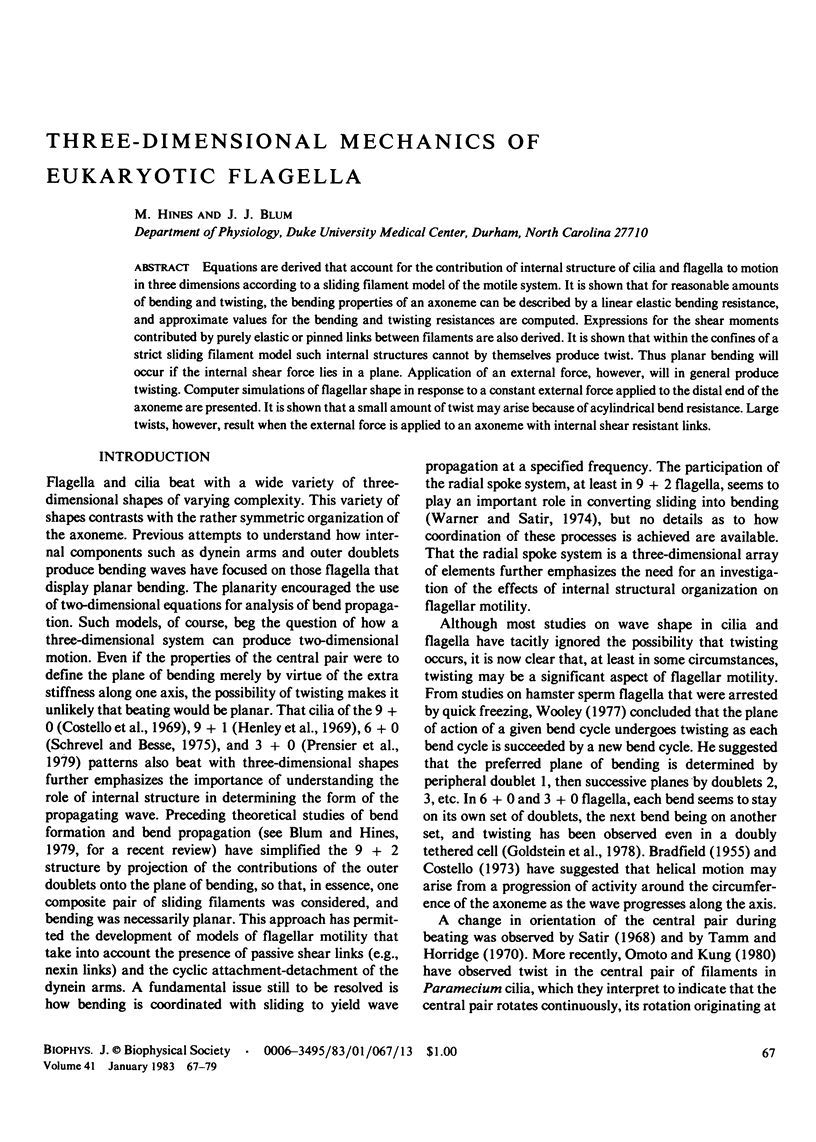
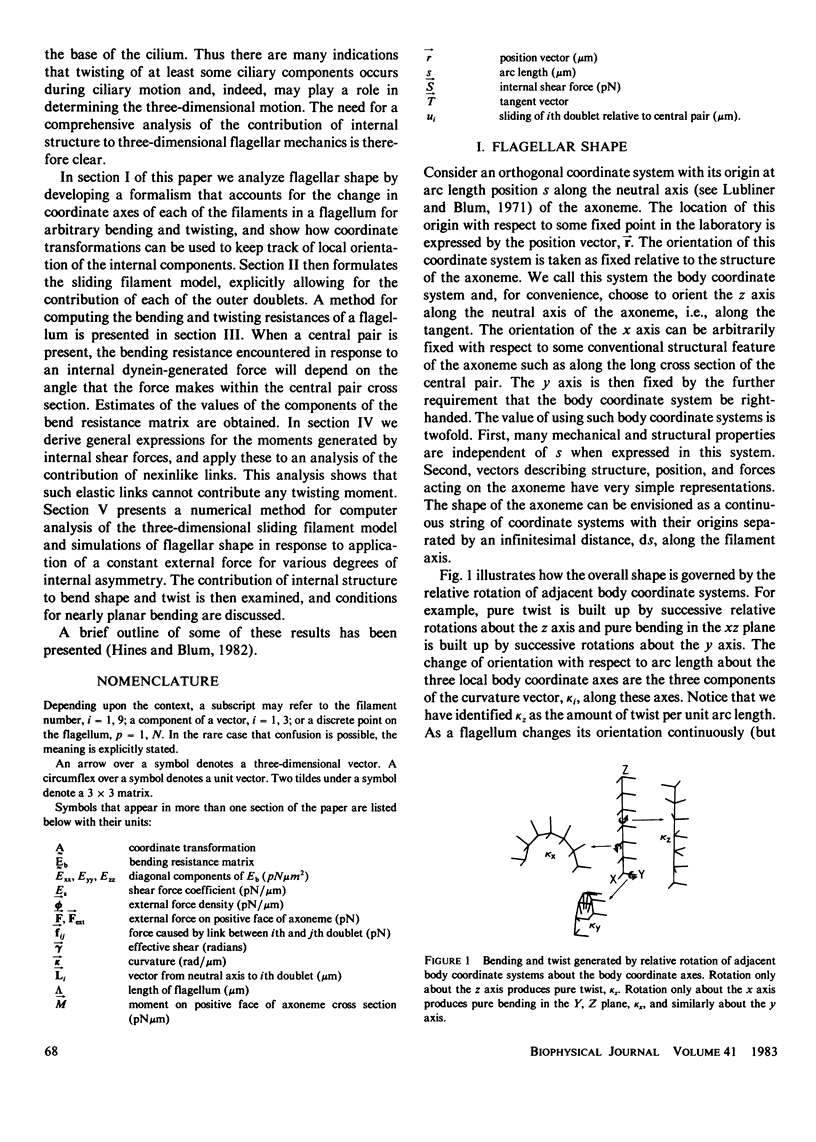
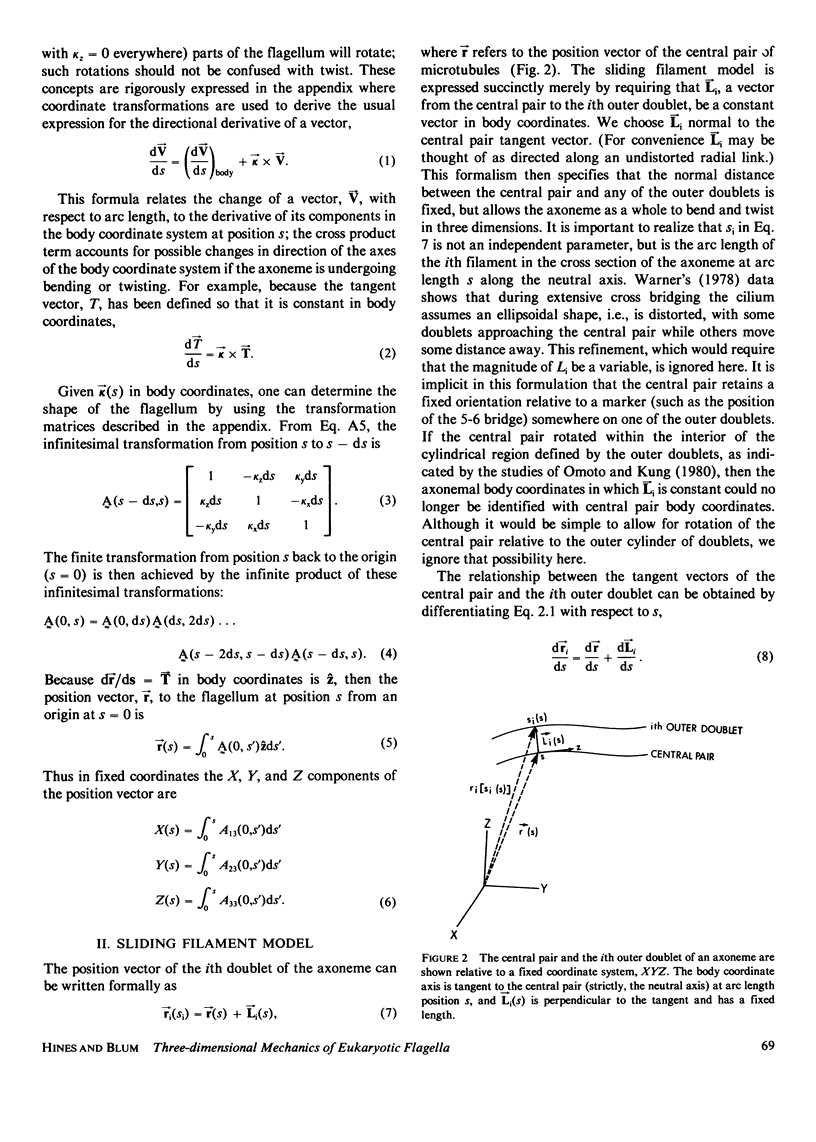
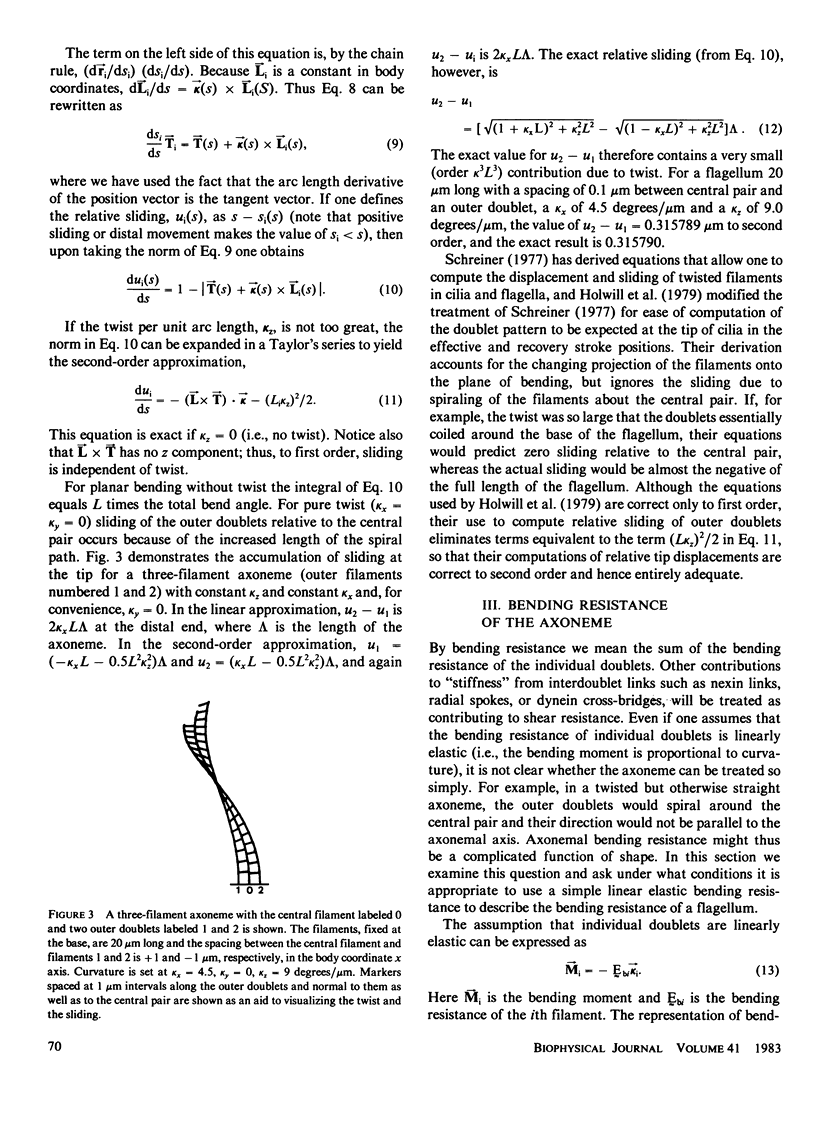
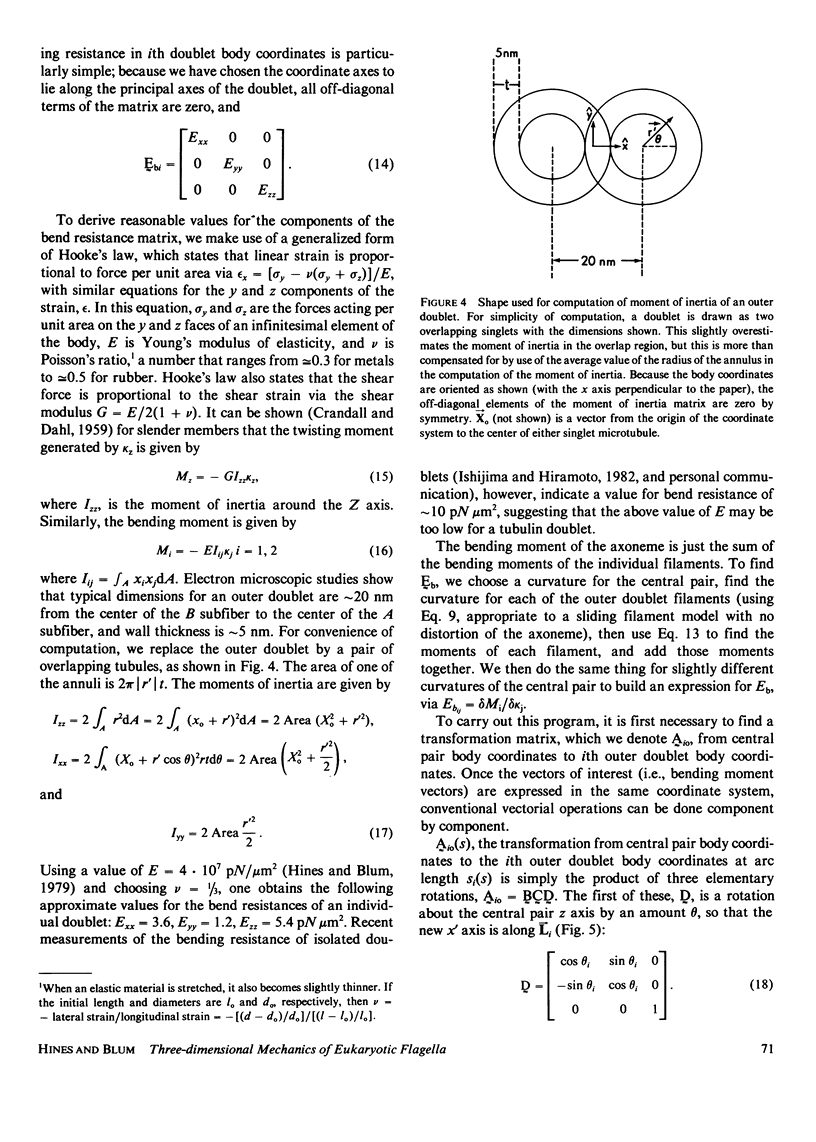
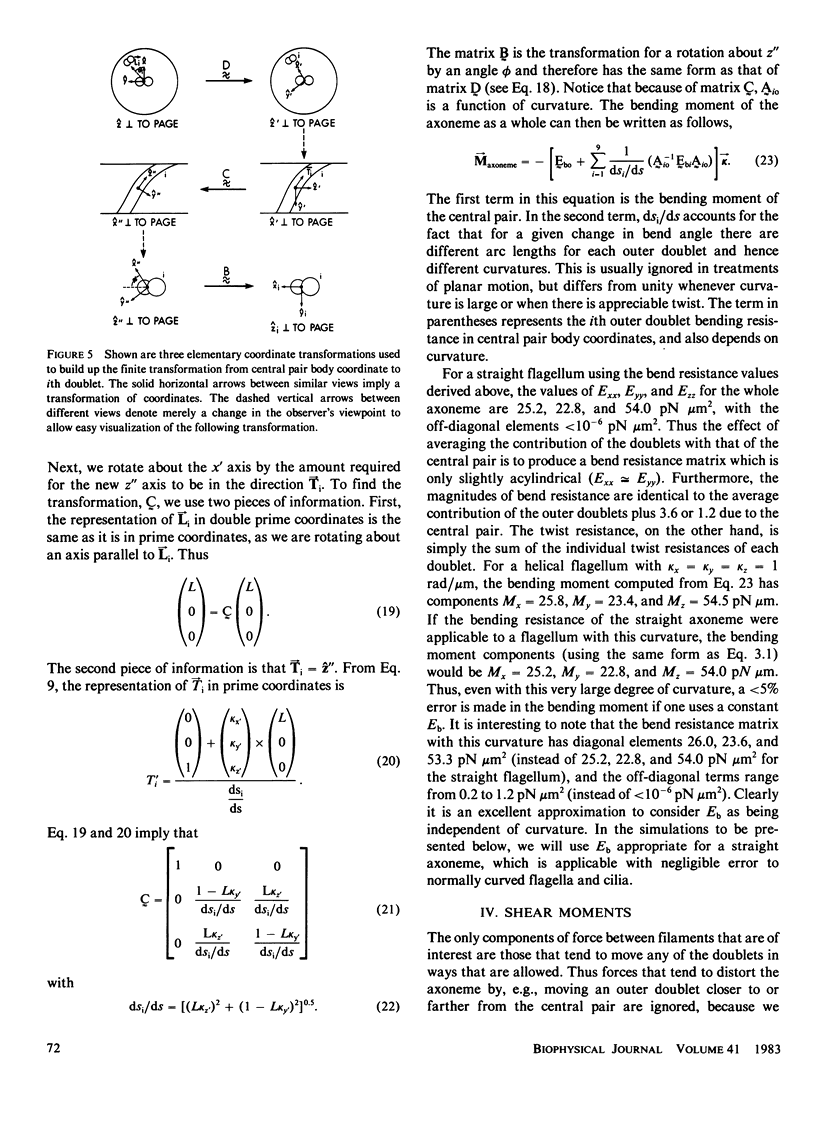

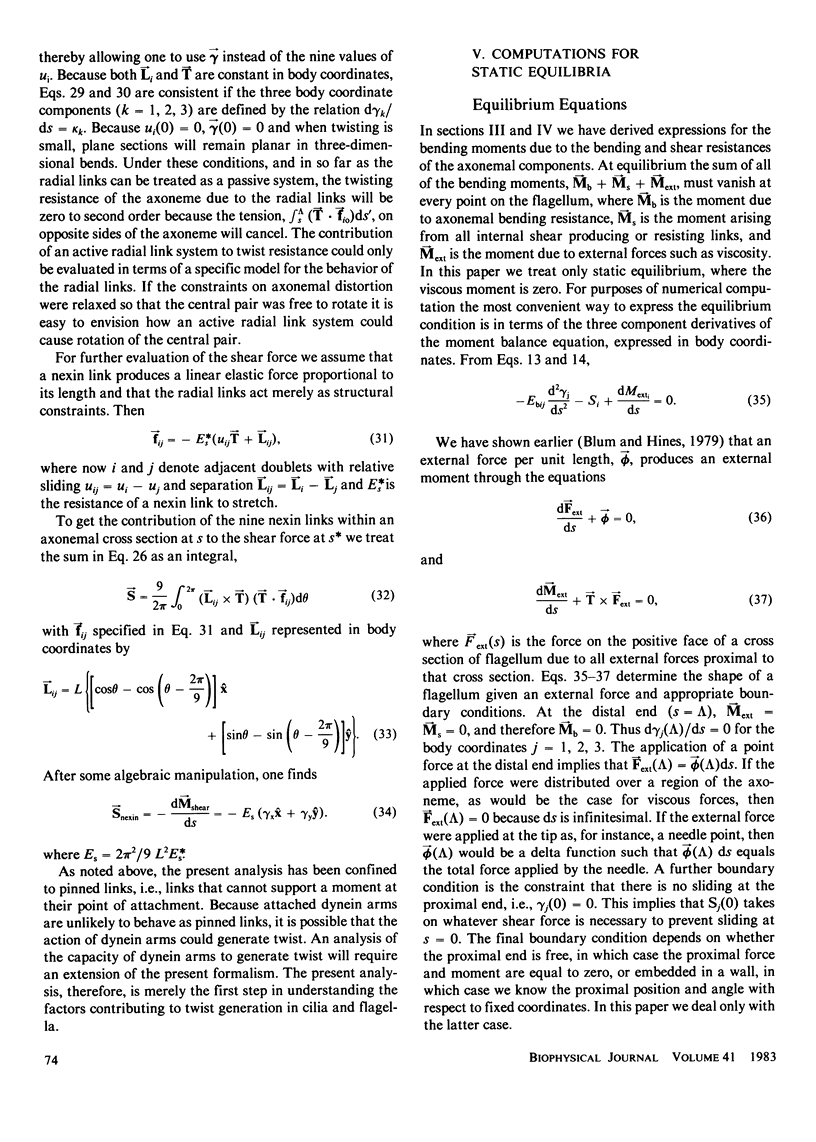
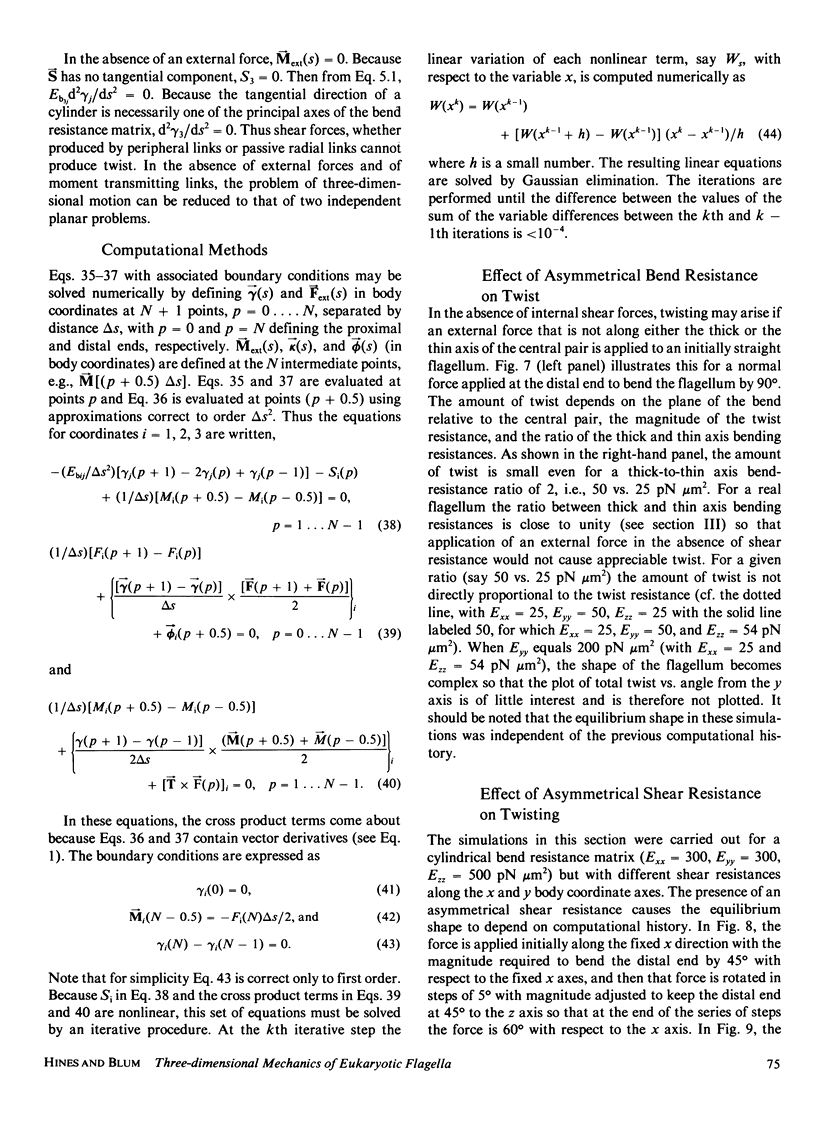
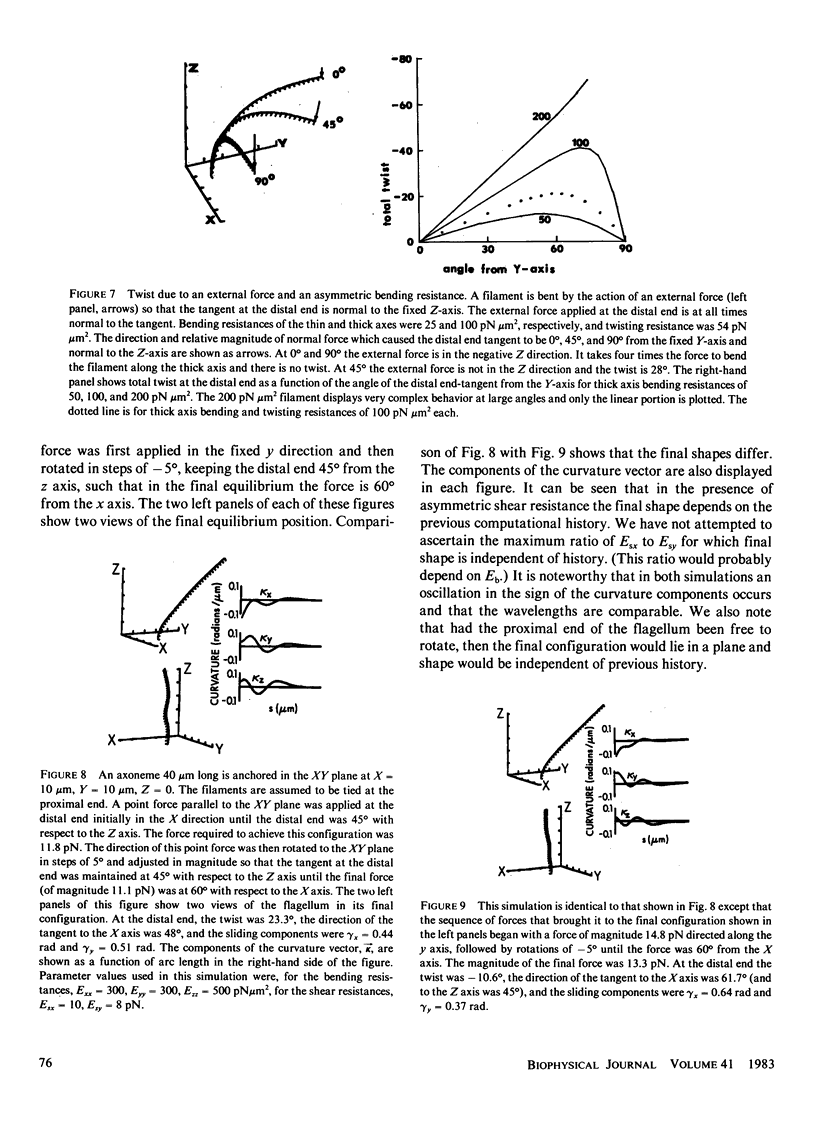
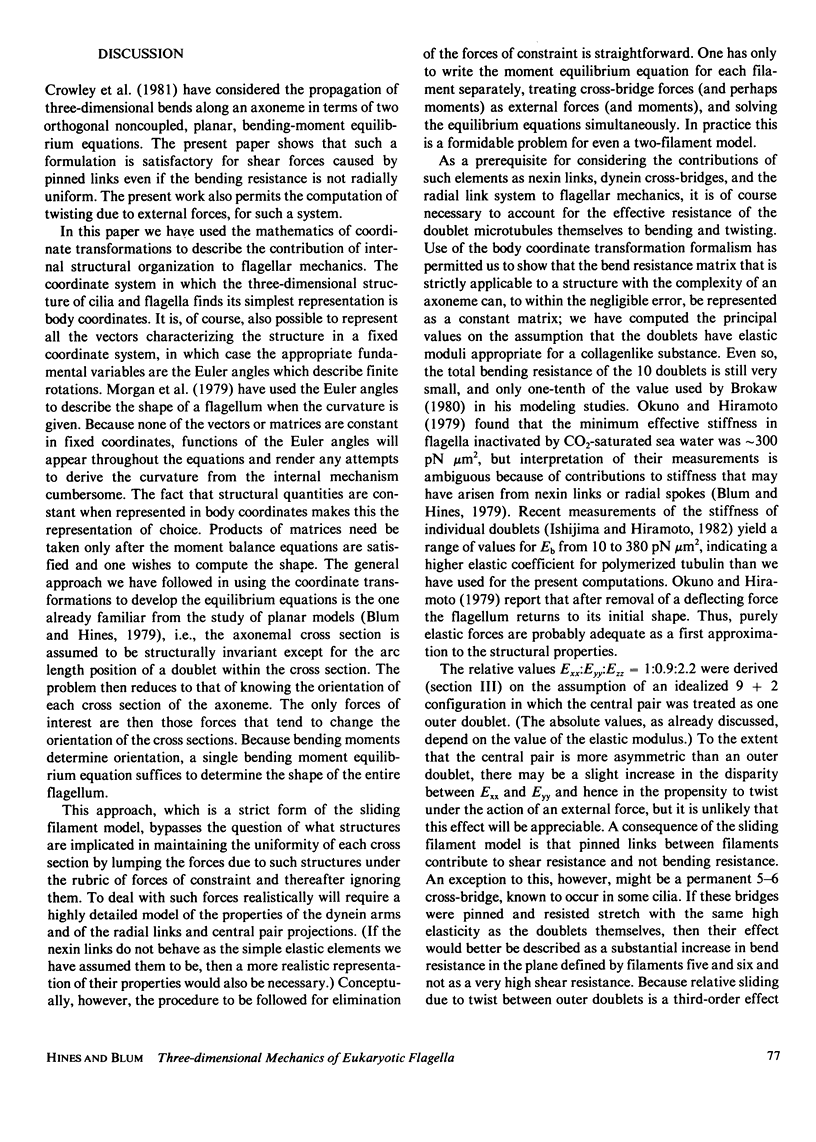
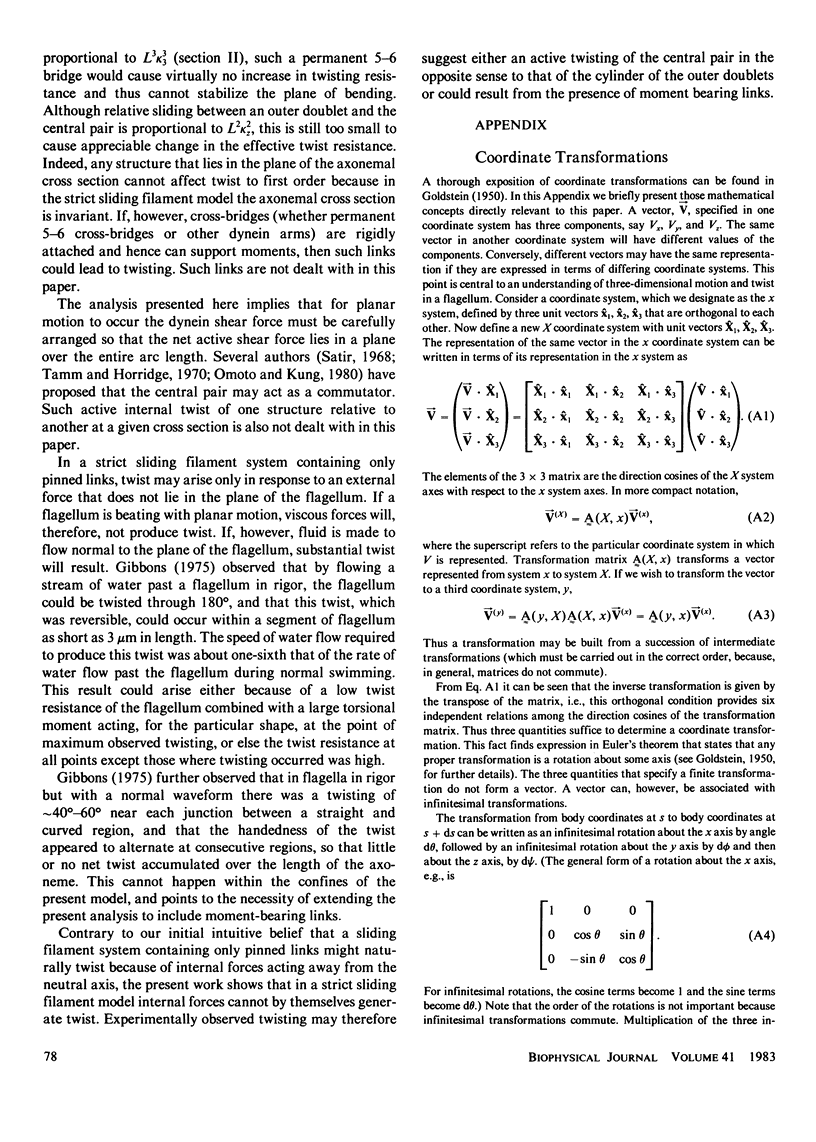
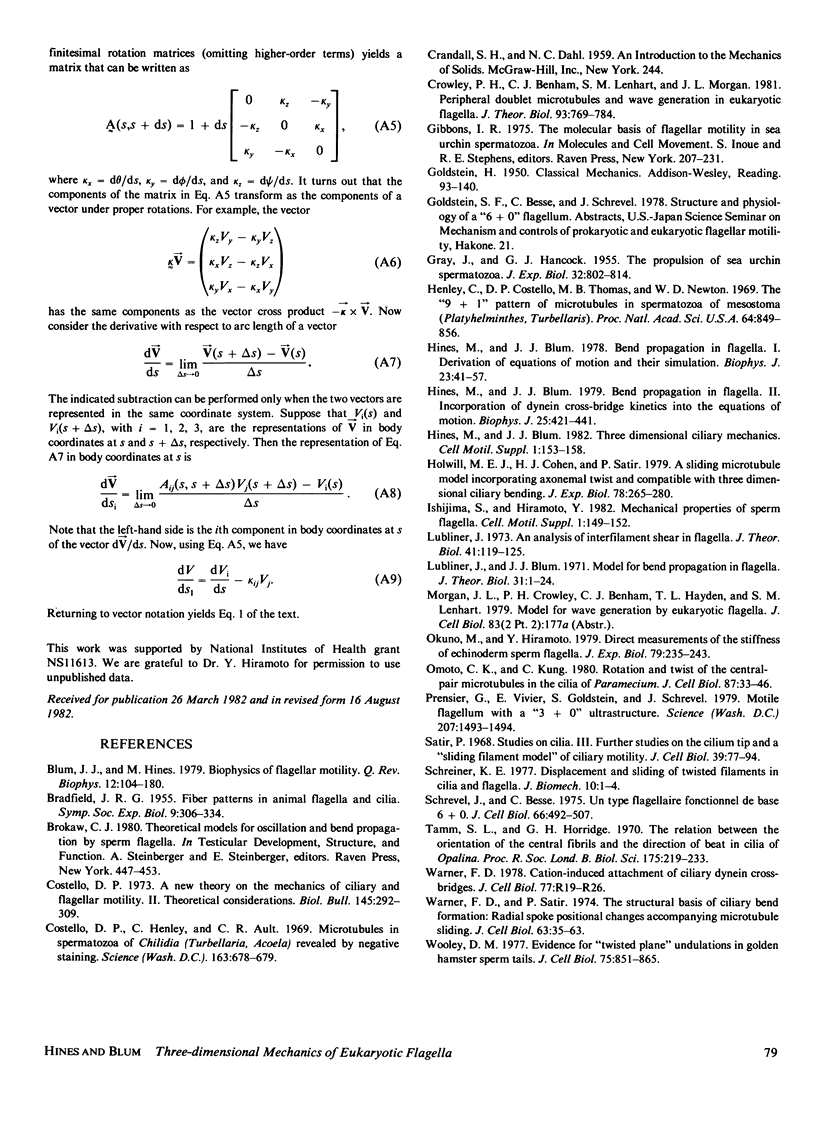
Selected References
These references are in PubMed. This may not be the complete list of references from this article.
- Blum J. J., Hines M. Biophysics of flagellar motility. Q Rev Biophys. 1979 May;12(2):103–180. doi: 10.1017/s0033583500002742. [DOI] [PubMed] [Google Scholar]
- Costello D. P., Henley C., Ault C. R. Microtubules in spermatozoa of childia (turbellaria, acoela) revealed by negative staining. Science. 1969 Feb 14;163(3868):678–679. doi: 10.1126/science.163.3868.678. [DOI] [PubMed] [Google Scholar]
- Costello D. A new theory on the mechanics of ciliary and flagellar motility. II. Theoretical considerations. Biol Bull. 1973 Oct;145(2):292–309. doi: 10.2307/1540041. [DOI] [PubMed] [Google Scholar]
- Crowley P. H., Benham C. J., Lenhart S. M., Morgan J. L. Peripheral doublet microtubules and wave generation in eukaryotic flagella. J Theor Biol. 1981 Dec 21;93(4):769–784. doi: 10.1016/0022-5193(81)90339-8. [DOI] [PubMed] [Google Scholar]
- Gibbons I. R. The molecular basis of flagellar motility in sea urchin spermatozoa. Soc Gen Physiol Ser. 1975;30:207–232. [PubMed] [Google Scholar]
- Henley C., Costello D. P., Thomas M. B., Newton W. D. The "9+1" pattern of microtubules in spermatozoa of Mesostoma (Platyhelminthes, Turbellaria). Proc Natl Acad Sci U S A. 1969 Nov;64(3):849–856. doi: 10.1073/pnas.64.3.849. [DOI] [PMC free article] [PubMed] [Google Scholar]
- Hines M., Blum J. J. Bend propagation in flagella. I. Derivation of equations of motion and their simulation. Biophys J. 1978 Jul;23(1):41–57. doi: 10.1016/S0006-3495(78)85431-9. [DOI] [PMC free article] [PubMed] [Google Scholar]
- Hines M., Blum J. J. Bend propagation in flagella. II. Incorporation of dynein cross-bridge kinetics into the equations of motion. Biophys J. 1979 Mar;25(3):421–441. doi: 10.1016/S0006-3495(79)85313-8. [DOI] [PMC free article] [PubMed] [Google Scholar]
- Hines M., Blum J. J. Three-dimensional ciliary mechanics. Prog Clin Biol Res. 1982;80:153–158. doi: 10.1002/cm.970020729. [DOI] [PubMed] [Google Scholar]
- Holwill M. E., Cohen H. J., Satir P. A sliding microtubule model incorporating axonemal twist and compatible with three-dimensional ciliary bending. J Exp Biol. 1979 Feb;78:265–280. doi: 10.1242/jeb.78.1.265. [DOI] [PubMed] [Google Scholar]
- Ishijima S., Hiramoto Y. Mechanical properties of sperm flagella. Prog Clin Biol Res. 1982;80:149–152. doi: 10.1002/cm.970020728. [DOI] [PubMed] [Google Scholar]
- Lubliner J. An analysis of interfilament shear in flagella. J Theor Biol. 1973 Sep 14;41(1):119–125. doi: 10.1016/0022-5193(73)90192-6. [DOI] [PubMed] [Google Scholar]
- Lubliner J., Blum J. J. Model for bend propagation in flagella. J Theor Biol. 1971 Apr;31(1):1–24. doi: 10.1016/0022-5193(71)90117-2. [DOI] [PubMed] [Google Scholar]
- Omoto C. K., Kung C. Rotation and twist of the central-pair microtubules in the cilia of Paramecium. J Cell Biol. 1980 Oct;87(1):33–46. doi: 10.1083/jcb.87.1.33. [DOI] [PMC free article] [PubMed] [Google Scholar]
- Prensier G., Vivier E., Goldstein S., Schrével J. Motile flagellum with a "3 + 0" ultrastructure. Science. 1980 Mar 28;207(4438):1493–1494. doi: 10.1126/science.7189065. [DOI] [PubMed] [Google Scholar]
- Satir P. Studies on cilia. 3. Further studies on the cilium tip and a "sliding filament" model of ciliary motility. J Cell Biol. 1968 Oct;39(1):77–94. doi: 10.1083/jcb.39.1.77. [DOI] [PMC free article] [PubMed] [Google Scholar]
- Schreiner K. E. Displacement and sliding of twisted filaments in cilia and flagella. J Biomech. 1977;10(1):1–4. doi: 10.1016/0021-9290(77)90024-0. [DOI] [PubMed] [Google Scholar]
- Schrevel J., Besse C. Un type flagellaire fonctionnel de base 6 + 0. J Cell Biol. 1975 Sep;66(3):492–507. doi: 10.1083/jcb.66.3.492. [DOI] [PMC free article] [PubMed] [Google Scholar]
- Warner F. D., Satir P. The structural basis of ciliary bend formation. Radial spoke positional changes accompanying microtubule sliding. J Cell Biol. 1974 Oct;63(1):35–63. doi: 10.1083/jcb.63.1.35. [DOI] [PMC free article] [PubMed] [Google Scholar]
- Woolley D. M. Evidence for "twisted plane" undulations in golden hamster sperm tails. J Cell Biol. 1977 Dec;75(3):851–865. doi: 10.1083/jcb.75.3.851. [DOI] [PMC free article] [PubMed] [Google Scholar]


